Researchers at Karolinska Institutet, the University of Manchester and Chalmers University of Technology have shown that the human immune system handles graphene oxide in a manner similar to pathogens, possibly leading to safer biomedical applications in the future.

Graphene oxide is currently being studied for use in various drug delivery methods and other medical applications (among other non-medical applications). However, it is of critical importance to understand how these materials interact with the body. The study shows that neutrophils, the most common type of white blood cell specialized in combating infections, release so-called neutrophil extracellular traps (NETs) when encountering GO. NETs are made up of a "spider-web" of DNA decorated with proteins that help neutrophils to destroy microorganisms such as bacteria and fungi.
"Taken together, these studies show that GO can be trapped and degraded in NETs just like pathogens. Understanding how the immune system senses and handles GO paves the way for safer biomedical applications of GO and other graphene-based materials, for instance in the context of drug delivery", say the researchers.

